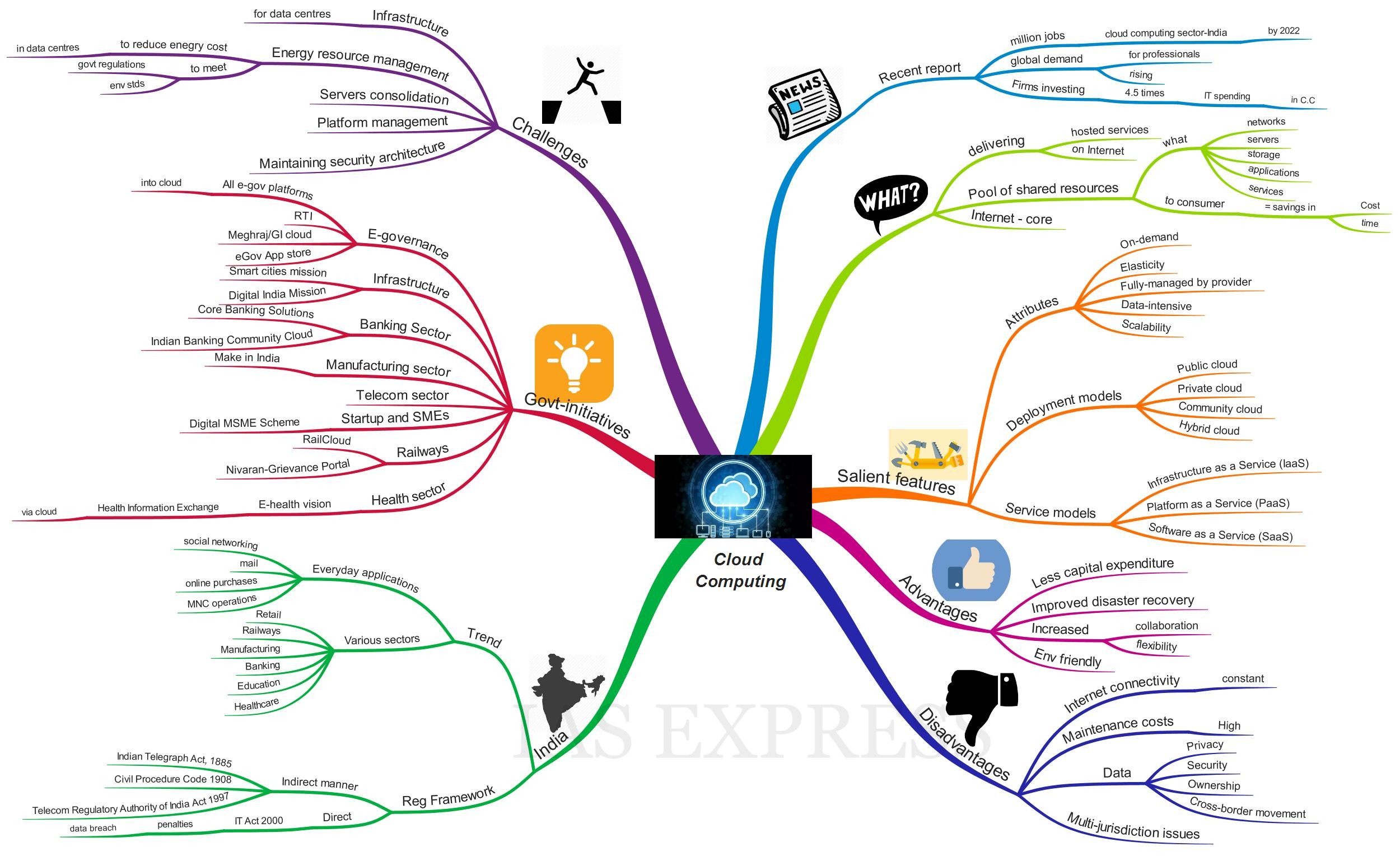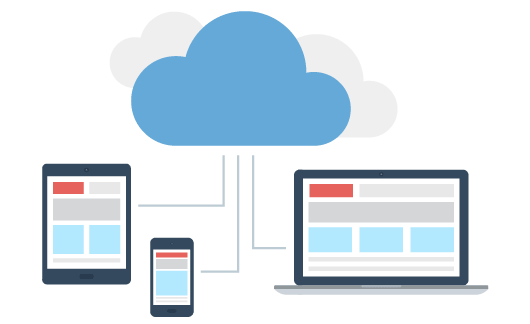Cloud Computing – Features, Merits, Demerits and Challenges

Due to a structural shift in operation of Indian businesses post-pandemic, the end-user expenditure on public cloud services in the country is expected to grow by another 30 per cent in 2022, based on a report by the tech research and consulting firm, Gartner. It will be the fourth consecutive year of double-digit growth in this sector.
What is Cloud Computing?
- Cloud computing means delivering hosted services over the internet.
- It is the pool of shared resources such as networks, servers, storage, applications, and services that can be provided to the consumer rather than the consumer managing them on her own which is costly and time-consuming.
- The Internet is at the core of evolution of this technology.
What are the salient features of Cloud Computing?
Attributes
- On-demand – It is sold on demand generally by the minute or the hour.
- Elastic – a user can have as much or as little of a service as they want at any given time.
- Fully managed by the provider – The consumer requires nothing but a personal computer and internet connection.
- Data-intensive – The focus is on data rather than computation.
- Scalability – Cloud computing has the ability to continue to function well when it is changed in size or volume in order to meet a user need.
Deployment Models
A cloud service works in 4 deployment models such as Public cloud, Private cloud, Community cloud, and Hybrid cloud.
Service Models
Cloud Computing services are divided into 3 categories
- Infrastructure as a Service (IaaS)
- Platform as a Service (PaaS)
- Software as a Service (SaaS)
What are the advantages of cloud computing?
Less capital expenditure
- Cloud computing services minimize IT requirements and physical storage, which helps small businesses, cut significant business costs.
- Most cloud services are paid on a subscription basis, so capital expenditure is reduced.
- Cloud computing is also much faster and easier to deploy, so there are fewer start-up costs.
Improved disaster recovery
Moving the business data to the cloud can make disaster recovery possible i.e., retrieving data in case of a hardware compromise.
Increased Collaboration and flexibility
- For many businesses, moving to the cloud enhances opportunities for collaboration between employees.
- Colleagues can sync and work on documents with ease, often simultaneously, receiving updates in real time.
- It allows team members to work from anywhere.
- Furthermore, the cloud centralizes the data = owner, employees and clients can access the company data from any location with internet access.
Environmentally friendly
- Cloud computing reduces a company’s carbon footprint by minimizing energy consumption and carbon emissions by more than 30%.
- For small businesses, the decreased energy usage can reach up to 90% = A huge money saver.
What are the disadvantages of cloud computing?
Internet connectivity
- For cloud-based services, consistent internet connection is important because if any one of the cloud-based service providers loses connectivity, then the company will be out of business until that internet connection returns.
- Even the best servers go down occasionally = Backup plan is important.
Maintenance costs
While the upfront or capital cost for the cloud-based server is very low compared to traditional hosting, the cloud server requires the same amount to be paid each month to maintain both servers as well as data.
Security
Companies with highly sensitive data may need their own IT department to keep data secure because when the data is stored in the cloud, the company is trusting a third party to keep it safe.
What is Cloud Computing trend in India?
- Cloud computing has found its applications in India in recent years as they are used in everyday activities of people such as social networking, mail, online purchases, and large-scale operations of MNCs including big data, Internet of Things (IoT), etc.
- Cloud Computing offers huge potential for Indian firms to grow and is opening up new windows of opportunities. Sectors like retail, railways, manufacturing, banking, education, and healthcare have started switching to cloud services.
What is the regulatory and legal framework for cloud computing in India?
- Cloud computing needs careful scrutiny by regulators due to its multi-dimensional nature.
- Legal frameworks should be mandated due to the concerns regarding cloud services like data privacy, data protection, data ownership, multi-jurisdiction issues, and disclosure and cross-border movement of data.
- While the Indian Telegraph Act, 1885, the Civil Procedure Code 1908 and the Telecom Regulatory Authority of India Act, 1997 deal with this sector in an indirect manner, the Information Technology (IT) Act of 2000 is of more relevance for regulating this sector.
- IT Act, 2000 – provides for provisions regarding penalties for the breach of data and privacy. The Act targets e-commerce and cybercrime in general and data protection and data privacy are covered under it.
- While the above-mentioned laws do cover some legal issues regarding cloud computing, however, they don’t cover the scope of cloud computing services and the issues arising from it.
What are the initiatives taken by the government in the cloud computing sector?
E-governance:
- The government has been exploring a cloud-based model to revolutionize its e-governance initiative.
- All e-governance platforms including State Wide Area Networks (SWANs, Data Centres etc) across the country could be transferred into cloud services in the near future.
- RTI: Government adopted cloud services in the domain of Right to Information (RTI) for efficient performances.
- Meghraj/GI Cloud: is the Government of India’s cloud computing platform used by government departments and agencies at the centre and states. It is an initiative of the Ministry of Electronics and Information Technology (MeitY).
- eGov App Store: The eGov App store is a common platform to host and run applications (developed by govt agencies or private players) at Meghraj which are easily customizable and configurable for reuse by different government agencies or departments at the centre and state levels without investing time or effort in the development of such applications.
Infrastructure sector:
- Smart cities mission facilitates local development by utilising technology such as cloud computing.
- Moreover, the government has also recognized the importance of cloud-based service delivery for Digital India since it integrates smart devices and infrastructure and processes a large amount of data from different sources in real time.
Banking sector:
- Reserve Bank of India (RBI) has been working towards achieving 100% financial inclusion with the help of technology. The RBI has been utilising cloud-based solutions, especially for cooperative banks to extend the banking services across India via core banking solutions.
- Use of cloud computing in the Banking sector will result in reduced timelines, moving the cost from capital expenditure to operational expenditure = banks could concentrate on core banking business.
- Indian Banking Community Cloud (IBCC) is the first community cloud initiative for banking sector in India.
Manufacturing sector:
- With Make in India initiative in full motion, adoption of cloud computing became even more relevant for the Indian manufacturing sector.
- Some common applications of Cloud Computing in the manufacturing sector are CRM (Customer Relationships Management), supply chain applications, data warehousing, information security, green IT, Human Machine Interface (HMI), and so on.
Telecom sector:
- Deploying operations and business support systems over cloud platforms is a highly effective method for resolving different business and technical challenges faced by the telecom sector.
- Cloud platforms provide an effective way to facilitate resource sharing, automation, monitoring, managing software upgrades and improving operations of telecom companies.
Start-ups and SMEs:
- The low capital investment and quick marketing time through cloud services encourage entrepreneurship in the country facilitating start-ups and small-medium businesses to start small and expand their business according to the demand.
- Digital MSME Scheme – It provides cloud-based services for MSMEs to reduce their cost by avoiding the building of in-house IT infrastructure.
Railways
- RailCloud – The Indian railways has launched RailCloud, a cloud-based service that will enable faster connectivity at a minimal cost.
- Nivaran-Grievance portal – It is the first IT application on the RailCloud. It is a platform for resolution of service related grievances of both serving and former railway employees.
Health sector
E-health vision of the government aims at incorporating the Health Information Exchange (HIE) mechanism through a cloud platform. An electronic HIE enables stakeholders to correctly assess and securely share a patient’s medical information electronically.
What are the challenges in the adoption of cloud computing in India?
- Infrastructure: Lack of effective infrastructure for data centres in India.
- Energy resource management: The cost of powering and cooling amounts to 53% of the total operational expenditure of data centres. The challenge is not only to reduce energy cost in data centres, but also to meet government regulations and environmental standards.
- Consolidation of servers: Achieving effective server consolidation (i.e., utilising the remote servers to the maximum level to reduce energy usage) without affecting application performance is a primary challenge.
- Platform management: Challenges in providing middleware capabilities for building, deploying, integrating and managing applications in a multi-tenant, elastic and scalable environments.
- Maintaining security architecture: The right cloud security architecture is needed for responding to security threats effectively and instantly and reducing risks associated with business or government services.
Also read: Nuclear Power Generation in India – Complete Analysis
If you like this post, please share your feedback in the comments section below so that we will upload more posts like this.



